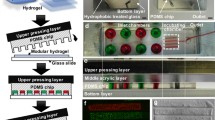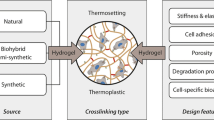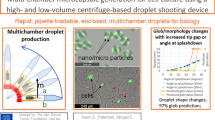Abstract
Here, we present a simple pipetting-based approach for generating multi-layered core-shell hydrogel droplets composed of alginate for outer shell and collagen for culturing cells inside. By using a multi-hole plastic substrate and by pipetting, multi-layered hydrogel droplets were generated in a simple and rapid manner. HEK293 cells, which are human embryonic kidney cells, were cultured for 14 days in double-layered hydrogel droplet with high viability. Cancer cells were co-cultured with epithelial cells in multi-layered hydrogel droplets and applied for drug tests with curcumin. As epithelial cells protect cancer cells from anti-cancer drugs, co-cultured cells showed lower sensitivity to curcumin. We developed a simple and easy method for creating complex hydrogel particles for 3D multicellular co-culture and developed an alternative method for drug testing in vivo.
Similar content being viewed by others
References
Griffith, L.G. & Swartz, M.A. Capturing complex 3D tissue physiology in vitro. Nat. Rev. Mol. Cell Biol. 7, 211–224 (2006).
Pampaloni, F., Reynaud, E.G. & Stelzer, E.H.K. The third dimension bridges the gap between cell culture and live tissue. Nat. Rev. Mol. Cell Biol. 8, 839–845 (2007).
Breslin, S. & O’Driscoll, L. Three-dimensional cell culture: the missing link in drug discovery. Drug Discov. Today 18, 240–249 (2013).
Bhadriraju, K. & Chen, C.S. Engineering cellular microenvironments to improve cell-based drug testing. Drug Discov. Today 7, 612–620 (2002).
Elliott, N.T. & Yuan, F. A review of three-dimensional in vitro tissue models for drug discovery and transport studies. J. Pharmaceutical Sci. 100, 59–74 (2011).
Breslin, S. & O’Driscoll, L. The relevance of using 3D cell cultures, in addition to 2D monolayer cultures, when evaluating breast cancer drug sensitivity and resistance. Oncotarget 7, 45745–45756 (2016).
Petersen, O.W., Ronnovjessen, L., Howlett, A.R. & Bissell, M.J. Interaction with basement-membrane serves to rapidly distinguish growth and differentiation pattern of normal and malignant human breast epithelial cells. Proc. Natl. Acad. Sci. USA 89, 9064–9068 (1992).
Tanaka, H. et al. Chondrogenic differentiation of murine embryonic stem cells: effects of culture conditions and dexamethasone. J. Cell Biochem. 93, 454–462 (2004).
Abbott, A. Cell culture: biology’s new dimension. Nature 424, 870–872 (2003).
Nelson, C.M. & Bissell, M.J. Of extracellular matrix, scaffolds, and signaling: tissue architecture regulates development, homeostasis, and cancer. Annu. Rev. Cell Dev. Biol. 22, 287–309 (2006).
Lee, J., Cuddihy, M.J. & Kotov, N.A. Three-Dimensional Cell Culture Matrices: State of the Art. Tissue Eng. 14, 61–86 (2008).
Pageau, S.C., Sazonova, O.V., Wong, J.Y., Soto, A.M. & Sonnenschein, C. The effect of stromal components on the modulation of the phenotype of human bronchial epithelial cells in 3D culture. Biomaterials 32, 7169–7180 (2011).
Luca, A.C. et al. Impact of the 3D microenvironment on phenotype, gene expression, and EGFR inhibition of colorectal cancer cell lines. PLoS One 8, e59689 (2013).
Tibbitt, M.W. & Anesth, K.S. Hydrogels as extracellular matrix mimics for 3D cell culture. Biotechnol. Bioeng 103, 655–663 (2009).
Saha, K., Pollock, J.F., Schaffer, D.V. & Healy, K.E. Designing synthetic materials to control stem cell phenotype. Curr. Opin. Chem. Biol. 11, 381–387 (2007).
Nguyen, K.T. & West, J.L. Photopolymerizable hydrogels for tissue engineering applications. Biomaterials 23, 4307–4314 (2002).
Lutolf, M.P. & Hubbell, J.A. Synthetic biomaterials as instructive extracellular microenvironments for morphogenesis in tissue engineering. Nat. Biotechnol. 23, 47–55 (2005).
Jongpaiboonkit, L. et al. An adaptable hydrogel array format for 3-dimensional cell culture and analysis. Biomaterials. 29, 3346–3356 (2008).
Smrdel, P. et al. Characterization of calcium alginate beads containing structurally similar drugs. Drug Dev. Ind. Pharm. 32, 623–633 (2006).
Rowley, J.A., Madlambayan, G. & Mooney, D.J. Alginate hydrogels as synthetic extracellular matrix materials. Biomaterials 20, 45–53 (1999).
Lee, K.Y. & Mooney, D.J. Alginate: properties and biomedical applications. Prog. Polym. Sci. 37, 106–126 (2012).
Annan, N.T., Borza, A.D. & Hansen, L.T. Encapsulation in alginate-coated gelatin microspheres improves survival of the probiotic Bifidobacterium adolescentis 15703T during exposure to simulated gastro-intestinal conditions. Food Res. Int. 41, 184–193 (2008).
Butcher, J.T. & Nerem, R.M. Porcine aortic valve interstitial cells in three-dimensional culture: comparison of phenotype with aortic smooth muscle cells. J. Heart Valve Dis. 13, 478–485 (2004).
Golden, A.P. & Tien, J. Fabrication of microfluidic hydrogels using molded gelatin as a sacrificial element. Lab Chip 7, 720–725 (2007).
Lee, W. et al. Multi-layered culture of human skin fibroblasts and keratinocytes through three-dimensional freeform fabrication. Biomaterials 30, 1587–1595 (2009).
Jeong, S.H., Lee, D.W., Kim, S., Kim, J. & Ku, B. A study of electrochemical biosensor for analysis of three-dimensional (3D) cell culture. Biosens. Bioelectron. 35, 128–133 (2012).
Hwang, H., Park, J., Shin, C., Do, Y. & Cho, Y.-K. Three dimensional multicellular co-cultures and anti-cancer drug assays in rapid prototyped multilevel microfluidic devices. Biomed. Microdevices 15, 627–634 (2013).
Sung, K.E. et al. Control of 3-dimensional collagen matrix polymerization for reproducible human mammary fibroblast cell culture in microfluidic devices. Biomaterials 30, 4833–4841 (2009).
Shamloo, A., Mohammadaliha, N., Heilshorn, S.C. & Bauer, A.L. A comparative study of collagen matrix density effect on endothelial sprout formation using experimental and computational approaches. Ann. Biomed. Eng. 44, 929–941 (2016).
Weaver, V.M. et al. Reversion of the malignant phenotype of human breast cells in three-dimensional culture and in vivo by integrin blocking antibodies. J. Cell Biol. 137, 231–245 (1997).
Bissell, M.J., Rizki, A. & Mian, I.S. Tissue architecture: the ultimate regulator of breast epithelial function. Curr. Opin. Cell Biol. 15, 753–762 (2003).
Zhang, K. et al. The collagen receptor discodin domain receptor 2 stabilizes SNAIL1 to facilitate breast cancer metastasis. Nat. Cell Biol. 15, 677–687 (2013).
Riching, K.M. et al. 3D collagen alignment limits protrusions to enhance breast cancer cell persistence. Biophys. J. 107, 2546–2558 (2014).
Koh, W.G., Revzin, A. & Pishko, M.V. Poly(ethylene glycol) hydrogel microstructures encapsulating living cells. Langmuir 18, 2459–2462 (2002).
Liu, V.A. & Bhatia, S.N. Three-dimensional photopatterning of hydrogels containing living cells. Biomed. Microdevices 4, 257–266 (2002).
Albrecht, D.R., Tsang, V.L., Sah, R.L. & Bhatia, S.N. Photo- and electropatterning of hydrogelencapsulated living cell arrays. Lab Chip 5, 111–118 (2005).
Smeds, K.A. et al. Photocrosslinkable polysaccharides for in situ hydrogel formation. J. Biomed. Mater. Res. 54, 115–121 (2001).
Chung, C. & Burdick, J.A. Influence of Three-dimensional hyaluronic acid microenvironments on mesenchymal stem cell chondrogenesis. Tissue Eng. A 15, 243–254 (2009).
Nichol, J.W. et al. Cell-laden microengineered gelatin methacrylate hydrogels. Biomaterials 31, 5536–5544 (2010).
Tan, W.-H. & Takeuchi, S. Monodisperse alginate hydrogel microbeads for cell encapsulation. Adv. Mater. 19, 2696–2701 (2007).
Tsuda, Y., Morimoto, Y. & Takeuchi, S. Monodisperse cell-encapsulating peptide microgel beads for 3D cell culture. Langmuir 26, 2645–2649 (2010).
Franco, C.L., Price, J. & West, J.L. Development and optimization of a dual-photoinitiator, emulsion-based technique for rapid generation of cell-laden hydrogel microspheres. Acta Biomater. 7, 3267–3276 (2011).
Koh, W.-G. & Pishko, M.V. Fabrication of cell-containing hydrogel microstructures inside microfluidic devices that can be used as cell-based biosensors. Anal. Bioanal. Chem. 385, 1389–1397 (2006).
Yu, L. et al. Core-shell hydrogel beads with extracellular matrix for tumor spheroid formation. Biomicrofluidics 9, 024118 (2015).
Chen, Q. et al. Controlled assembly of heterotypic cells in a core-shell scaffold: organ in a droplet. Lab Chip. 16, 1346–1349 (2016).
Lu, Y.-C. et al. Designing compartmentalized hydrogel microparticles for cell encapsulation and scalable 3D cell culture. J. Mater. Chem. B 3, 353–360 (2015).
Mahow, R., Meier, R.P.H., Bühler, L.H. & Wandrey, C. Alginate-Poly(ethylene glycol) Hybrid Microspheres for Primary Cell Microencapsulation. Materials 7, 275–286 (2014).
Anderson, T., Auk-Emblem, P. & Dornish, M. 3D Cell Culture in Alginate Hydrogels. Microarrays 4, 133–161 (2015).
Dietmair, S. et al. A Muiti-Omics Analysis of Recombinant protein Production in Hek293 cells. PLoS One 7, e43394 (2012).
Inoki, K., Li, Y., Zhu, T., Wu, J. & Guan, K.-L. TSC2 is phosphorylated and inhibited by Akt and suppresses mTOR signaling. Nat. Cell Biol. 4, 648–657 (2002).
Seth, R.B., Sun, L., Ea, C.-K. & Chen, Z.J. Identification and Characterization of MAVS, a Mitochondrial Antiviral Signaling Protein the Activates NF-κB and IRF3. Cell 122, 669–682 (2005).
Mai, A. et al. Distinct c-Met activation mechanisms induce cell rounding or invasion through pathways involving integrins, RhoA and HIP1. J. Cell Sci. 127, 1938–1952 (2014).
Shao, N. et al. Hydrogen-bonding dramatically modulates the gene transfection efficacy of surface-engineered dendrimers. Biomater. Sci. 3, 500–508 (2015).
Yoon, M.J., Kim, E.H., Kim, J.H., Kwon, T.K. & Choi, K.S. Superoxide anion and proteasomal dysfunction contribute to curcumin-induced paraptosis of malignant breast cancer cells. Free Radic. Biol. Med. 48, 713–726 (2010).
Liu, Q., Loo, W.T.Y., Sze, S.C.W. & Tong, Y. Curcumin inhibits cell proliferation of MDA-MB-231 and BT-483 breast cancer cells mediated by down-regulation of NFB, cyclinD and MMP-1 transcription. Phytomedicine 16, 916–922 (2009).
Tate, T. On the magnitude of a drop of liquid formed under diffferent circumstances. Phil. Mag. 22, 176–180 (1864).
Perez, R.A. et al. Utilizing core-shell fibrous collagen-alginate hydrogel cell delivery system for bone tissue engineering. Tissue Eng. A 20, 103–114 (2014).
Carey, S.P., Starchenko, A., Mcgregor, A.L. & Reinhart-King, C.A. Leading malignant cells initiate collective epithelial cell invasion in a three-dimensional heterotypic tumor spheroid model. Clin. Exp. Metastasis 30, 615–630 (2013).
Author information
Authors and Affiliations
Corresponding author
Rights and permissions
About this article
Cite this article
Yeon, J.H., Chung, S.H., Baek, C. et al. A Simple Pipetting-based Method for Encapsulating Live Cells into Multi-layered Hydrogel Droplets. BioChip J 12, 184–192 (2018). https://doi.org/10.1007/s13206-018-2307-z
Received:
Accepted:
Published:
Issue Date:
DOI: https://doi.org/10.1007/s13206-018-2307-z




